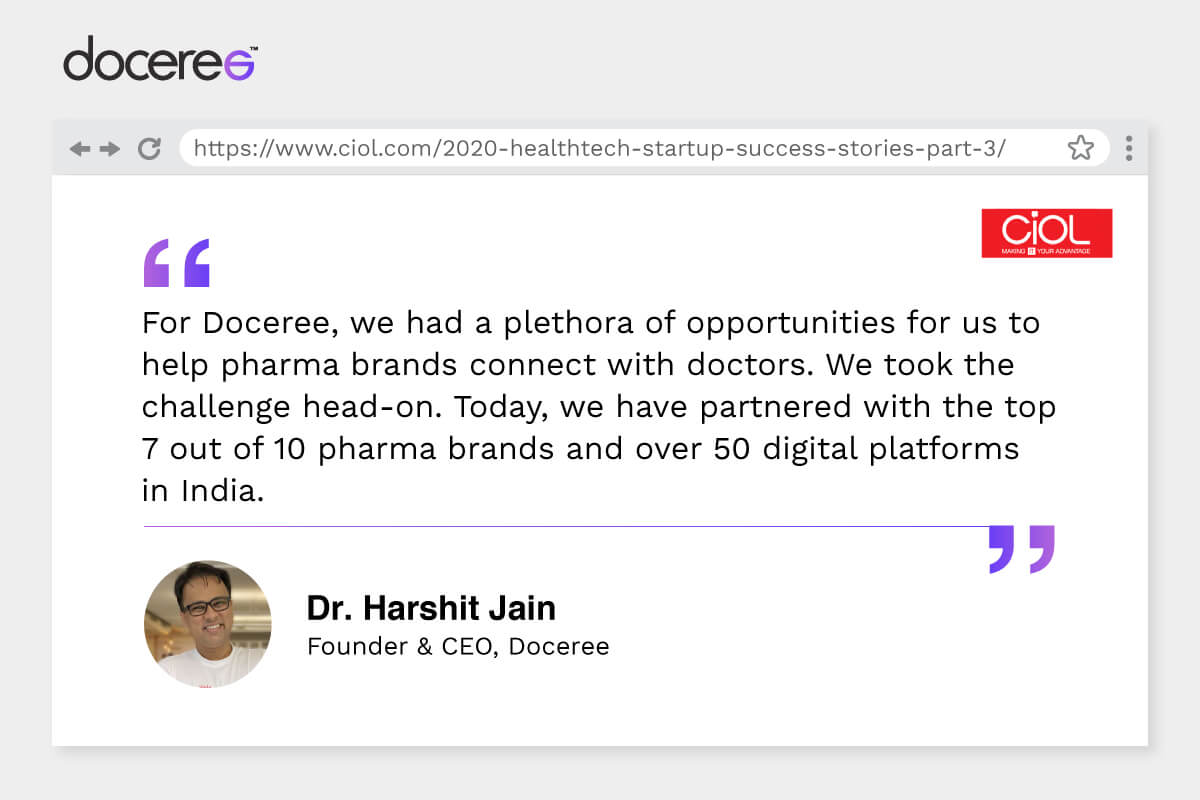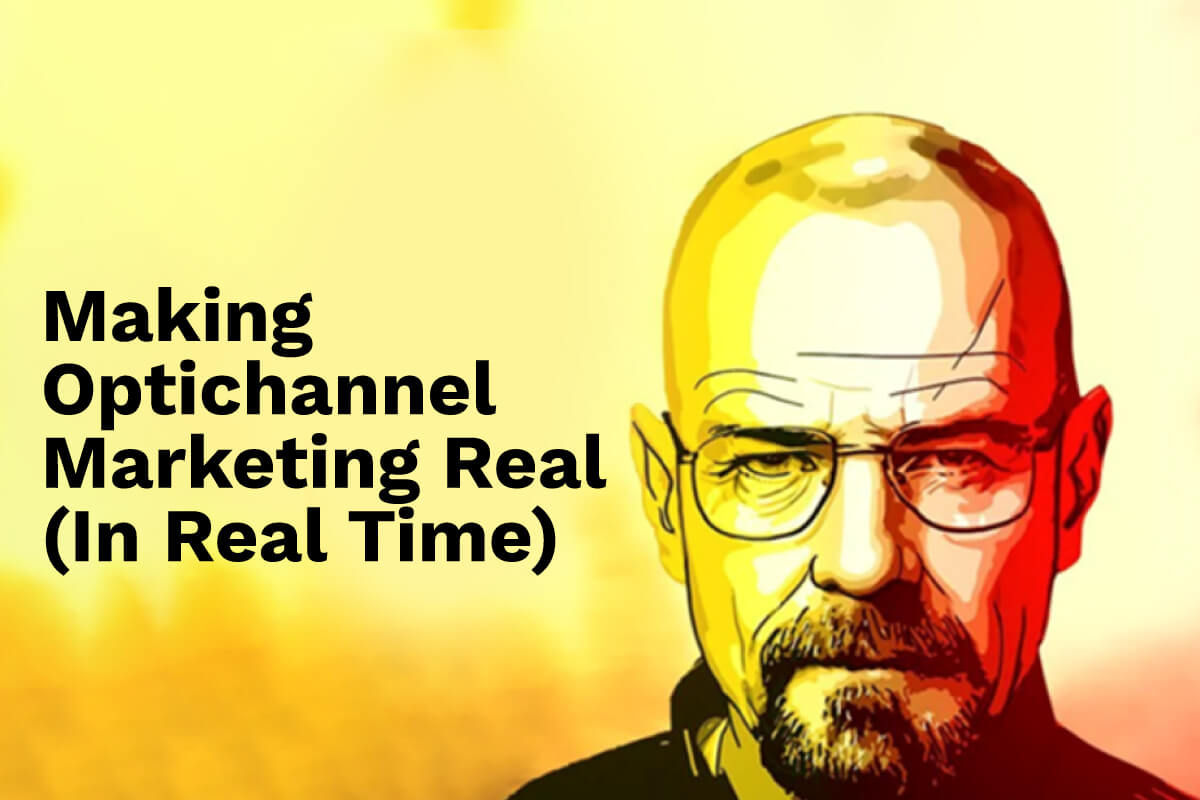HealthTech: The year (2020) that went by and how it faired





Point of Care advertising is a healthcare marketing strategy that was traditionally applied to waiting rooms, examination rooms, doctor’s offices, pharma shops, and so on. The concept of point of care advertising is not alien to people in the Pharmaceutical or medical industry, but of late, it has started pacing up more than before. This is because digital marketing has been picking up the much-needed momentum and is everybody’s best bet today due to the ongoing pandemic. There has been a noticeable spike in ad fundings as well.
POC advertising is very educative and acts as a key driver for conversations between Physicians and pharma marketers. The pharma industry has been playing a pivotal role in facilitating the progress of POC advertising on telehealth platforms. This helps them with precision targeting and proper delivery of messages via technology to the targeted audience. Here are a few more reasons why pharma brands are leaning more towards POC advertising:
POC advertising plays a critical role in influencing people’s opinions. When compelling enough, people switch brands, or ask for samples to be provided, or even raise requests for specific drugs. These ads are very informative, and they push people’s minds to use branded medications in comparison to generic ones. Doceree’s Physician-only platform enables the pharma industry to engage with Physicians on a one-on-one basis with impactful ad placements that suit their needs. It allows for real-time tracking and programmatic marketing that further helps in the process.
Many pharma companies have already made the necessary shift for proper targeting and advertising. To be in the game and get their brands across for sales to happen, other brands are joining in as well. It is a well-known fact that marketing, sales, and advertising in the pharma industry are not an easy task. Until recently, sales representatives would visit medical professionals in person, but today, such processes have shifted online. Many Pharma companies and Physicians have joined Doceree’s online platform to have a seamless interaction regarding these affairs.
Traditionally, point of care advertising has been very effective on patients. But pharma companies have been trying to be one step ahead and extending this to the Physicians. Doctors are always on the move owing to their jobs, but they are also always on the lookout for good educational content and opportunities. They are on some electronic device or the other to keep up with their daily tasks, and so, pharma brands should have both the content and the message ready, that hits the bullseye in one go. Giving information through medical journals or advertising on medical journals, both online and offline, are good approaches too. Doceree supports the latter. It also offers a plethora of information for physicians to view and digest. Put simply, Doceree makes the best use of technology for the proper dissemination of ads and information.
Since most pharma companies have already started making use of digital marketing platforms, it is important to keep a note of what is getting their competitors ahead. Keeping these factors in mind helps gain a competitive edge over other players in the market. Visual content is a game-changer in these situations. Physicians like to see how the drug or medical device in question can help their patients. A visual representation also ensures proper communication and acts as an attraction factor to take things forward. Doceree’s platform makes sure that all these processes take place smoothly. Its programmatic marketing solutions provide the much-needed traction that Pharma brands require. Besides, its AI-enabled technology Espyian enhances the user experience via real-time optimization, and tracking becomes much more comfortable.
Advertising on EHR has gained a lot of momentum in the past couple of months. They are platforms that show the best digital ad banners and messages to Physicians. They are a great way of improving brand perception because this method of advertising tries to send out information that is more Physician-centric, rather than being too promotional.
Evolution and adaptation are crucial to survival. Advertising in the pharma industry is getting a facelift and moving on towards more futuristic methods with the aid of technology. The use of pamphlets and TV ads viewership is reducing and is assumed to drop further in the coming years since people are switching to new streaming spaces on a regular basis. Similarly, digital marketing and point of care methods will invest accordingly for better sales, profit margins, and outreach. The content will be customised accordingly, as well. The upcoming future will definitely see a lot of content-specific POC advertising, and this is one of the factors that will help pharma companies achieve their goals.

We know from neuroscience that the state of mind is critical to the receiver of a message. For example, if someone is in a state of fear (or shock), they are not likely to remember information that is shared with them in that moment. For example, fans of Breaking Bad may remember that Walter White glazed over and became fixated on a mustard stain on his Oncologist’s lab coat instead of being able to hear and process the prognosis, path forward and treatment options that his doctor was explaining to him.
If your brand wants to connect with Physicians, it makes sense that you should attempt to reach them when their mind is on medicine and within in the context of care. Why?
You spend a significant number of resources to research and understand your customers and their unmet needs that your product will fulfill. You craft a message that is clear and precise, and benefits based (or maybe brand-based if you are raising awareness). We know from historical global launch data that the first six months of market trajectory for new launch products will establish the ultimate success potential for your brand. The peak sales figure that you will reach is related to the market’s reaction to your launch story.
Additionally, the emerging science covering professional rejuvenation strategies indicates that downtime from our work-life is critically important to us in that it supports our ability to continually operate at a peak-state while we are on the job.
For brand marketers who wish to engage Physicians when it makes most sense, do it when their minds are turned-on to their work, wherever that may be. The timing and context that your message will land best for Physicians is while she/he:
Physicians have repeatedly acknowledged that sponsored messages enable them to stay up the curve on contemporary diagnostic methods and new treatment alternatives. As you plan your campaign, some questions to ask yourself are:
If you want to serve your brand and the Physician communities in the best possible manner, consider reaching them when their mind is open to the information that you want them to see and interact with. That’s one. The second most critical aspect is to contextualize your message or information as per the platform you are engaging them on to provide Physicians a personalized experience. This is an important determinant to the overall success and impact of your communications strategy.
As my colleague and our Vice President of Customer Success expresses it simplistically:
Omnichannel + Contextual = Optichannel
To learn about how Doceree is enabling brands to get the best of the optichannel strategy in real time, drop in a line at john.spingler@doceree.com



Today’s world is moving at an alarming rate – new technologies, faster methods, quick fixes – the list is endless. People like convenience and accessibility, and the switch to digitalization enhances them to do precisely that – it gets the work done from wherever, whenever. In the process, a lot of time is saved as well. Apart from being hit by the ongoing COVID-19 pandemic, countries worldwide have also been hit by an enormous digital wave. This has only furthered our path towards digitalization.
Over time, businesses have realized the importance of online presence. Digital marketing to Healthcare professionals has slowly come to unfold as something that is imperative for both the pharmaceutical industry and healthcare physicians – especially now because healthcare is of prime importance considering the pandemic, and many people are looking for possible online solutions. For most Pharmaceutical companies that sell drugs and other medical devices, the sales process happens via their company’s representative. They visit doctors and sell the medication or device individually. However, thanks to COVID-19, the pharma sector has finally started catching up with digital marketing techniques. Here are a couple of reasons why:
Pharma marketing and consumer marketing are very different. They do not go hand in hand. Pharmaceutical brands have barely taken the digital leap to reach out to doctors and medical professionals. Using programmatic marketing platforms like Doceree’s, which is especially doctor specific in nature, the pharmaceutical sector can effectively target medical professionals and Physicians as per their products and services, thereby rendering a streamlined approach to their targets.
Using such AI-enabled platforms will only make the process faster as pharma companies will automatically get aligned with experts who might require their products. The entire process will save tons of time and money. The doctors can be targeted at the proper time with the right kind of content to get maximum returns. Apart from being just target-oriented, a digital platform can act as a medium that allows pharma companies to exhibit their products and services for scores of doctors to see.
By using platforms that allow Pharma companies and the Physicians to interact, both direct communication and accessibility are taken care of. About 70 percent of people get in touch with businesses because of digital marketing alone – says a survey in Biz Report This one-on-one interaction also extends a personal touch to the whole situation, wherein medical firms and professionals can engage with each other on issues specific to their profiles, that too on a global scale.
Approaching via digital marketing means that one has to continuously develop new ideas to make the user experience more personalized and delightful. Though marketing to medical professionalsmight seem like an alien concept to many, it has actually become quite common.
Having a digital presence also gives space for online reviews and feedback. By pitching and selling their products to medical experts via digital marketing, pharmaceutical companies can get productive feedback from their fellow clients, which they can use to work on for their future campaigns and strategies.
The positive reviews also help in building the reputation of the pharmaceutical brand within the online medical community. This plays a pivotal role in shooting up sales, getting referrals for potential clients, and ensuring a more significant outreach. Hence, digital medico marketing will do well with an all-round approach.
Digital marketing is very cost-effective. Usually, a lot of money is spent on the acquisition of clients. Whenever doctors or healthcare professionals meet a pharmaceutical sales representative, a decent amount of money is spent on every interaction. Doing this on a digital platform cuts down costs by a fair margin. The entire task becomes very efficient, and the money saved can be used for other purposes that help take the business forward. We at Doceree offer cost-effective marketing solutions to Pharma brands so that they can make the most of their time and money.
Since many Pharma Companies are yet to come on board with the whole digital aspect, the ones already adopting it can stay ahead of their competitors. Online work also enables one to analyze data effortlessly and make statistically sound decisions so that the business is positively impacted. Ad campaigns can be designed by analyzing available data to gain maximum response (Doceree’s AI-enabled platform helps achieve the same).
The more one gets used to the idea of Healthcare digital marketing, the content strategy too becomes extremely important and indispensable. Having an SEO strategy in place; having a website that is compatible with phones; conducting surveys to ensure best practices; posting images and videos; email marketing; digital ad campaigns – these are all the things that enhance the web presence of any firm or organization.
By using digital marketing platforms to reach out to Physicians, pharma companies can continue to cater to doctors’ needs without actually hampering their job of looking after their patients. This method creates a fine line between a doctor attending to Pharma representatives and their patients.
The whole idea of digital medico marketing is to stay at the top of your game with a good plan, and it helps in a smoother transition from one level to another. A digital marketing strategy will immensely help in making decisions that otherwise can be hard to make. No matter how reluctant pharma companies were to use digital platforms, COVID-19 has left them with no choice. Traditional formulas alone could not work for now. Therefore, it is safe to say that digital marketing to healthcare professionals is the need of the hour.
To know more about the services we provide, click here!

Marketing is all about creativity. It is about how one can align their products and services with that of the target market. It is about acknowledging the need and planting that desire for sales to happen. Since healthcare marketing is quite different from the usual, conventional, consumer marketing, it had been a little difficult initially to navigate the entire sales process in this arena. Nevertheless, pharmaceutical companies always found one way or another to squeeze in some time into the schedule of healthcare experts. It sure has been difficult to grab the attention of doctors this way because even after meeting them, their routine does not allow for a proper conversation or a response that the pharmaceutical companies expect. So, here question arise how to market to physicians?
However, today, marketing to doctors is not that great a challenge anymore. Digital Marketing offers new methods and ideas that are continuously evolving for advertising to doctors, and fortunately, they seem to be working well enough. Here are five reasons why:
Using online platforms like Doceree’s to showcase products and services via good content is a great way to turn some heads. Adopting the digital way basically allows pharma and medical companies to engage doctors in their free time. This way, medical and health professionals can give proper attention to what they are reading and take actions accordingly. Digital marketing to doctors is a great way to share some good educational content – it can include information on how the products or drugs work, why they can be helpful, and the kind of results that can be expected from them.
Accurately targeting Physicians is what happens on Doceree’s platform, and since it works on a global scale just for doctors, the traction is equally good. Email marketing has turned out to be one of the most preferred modes of communication for doctors and healthcare professionals. In fact, they prefer it more to receiving mails directly, or being visited by sales representatives from pharmaceutical companies. This is because it is quite difficult for them to take out time from their busy schedules. Further, emails today also happen to be the best way to inform medical professionals about new products, medical technology, and matters related to the healthcare and pharma industry.
HCPs cannot be convinced with bare minimum information or data regarding a drug or a product. For persuading a medical professional that a particular product is worth their time and attention, extensive information needs to be given and all of it can be done via a single interface that that of Doceree’s. Often, several stakeholders are involved when it comes to making the final purchase decision. Therefore, providing a clear picture of how a drug will work, how it will help an individual, the clinical data associated with it – all these factors will play a crucial role in the convincing part of the strategy. HCPs also appreciate proper and detailed information, and hence, they like medical educational programs with respect to drugs and devices.
Digital marketing and advertising today are mainly driven via big data, insights into customers’ behaviour on online platforms, and analytics. Doceree offers a combination of programmatic marketing platforms such as DSP, SSP, etc. so that all the requirements of the involved parties are looked after under one umbrella. Proper programmatic marketing, emailing or advertising can help streamline the target audiences for Physician digital marketing automatically and control the display ad purchases. This method traces the research trends of customers online to present ads to them as per their requirements keeping the opportune timing in mind.
Doctors and healthcare professionals are on their toes all day – either they have to take care of appointments or scrub in on surgeries or just take some time off to rest. Amidst all this, it is difficult to spend time in one place. Therefore, it is not easy to make a doctor sit and listen to a pitch. This is where mobile marketing strategies come in – advertisements and messages go wherever the HCPs go. Having websites that are responsive on phones are essential. This is where programmatic email marketing comes in as well – not very time consuming, but enough to grab one’s attention.
One critical reason as to why pharma companies have been reluctant to go digital is because of non-transparency of doctor reach and results. Thanks to Doceree’s AI-enabled dashboard, marketing to Physicians is ensured, that too with real time updates on media campaigns. It offers full transparency apart from also increasing the efficiency for better, optimal marketing – that is, reaching out to prospective HCPs and also getting immediate results that can be tracked and tallied. This clears the path for implementation of future campaigns.
The markets today are very competitive and the pandemic has only made it more difficult for pharma companies to engage in the traditional forms of engagement and sales. Digital marketing is the fastest growing solution today, and the pharma industry is slowly making the switch – which will definitely bring in benefits in the future.
For more information on how one can effectively engage in Physician digital marketing, click here !

To help you prepare for a world without 3rd party cookies, let’s first understand how 3rd party and 1st party cookies work currently; what does the ban “actually” mean for the Publishers; and how you can build a strategy to survive in a post 3rd party cookie world.
First party cookies are cookies that belong to the primary domain visited by the user. So, if you’re visiting example.com, first party cookie containing user data would only be accessible to example.com.
Third-party cookies don’t originate from the primary domain visited by the user. These cookies often result from the services publishers add to make their sites work better (like adding social buttons or chat services or others).
For Ad-Tech industry, targeting is the most essential component. Third party cookies allow advertisers and ad exchanges to track the websites visited, time spent on each website, clicks, locations, etc. of a user which help them follow the user and show them the same advertisement or its sequel wherever they go without even asking the user to login on those websites.
3rd party cookies help track users and their activities across domain. This helps publishers earn better CPMs because they are able to provide relevant information to advertisers. What happens if the advertisers can no longer access the third party cookies? First party data/cookie will become paramount. If third party cookies are banned, then you can only access first party data to make an informed decision about which ad to show to the user.
Now, that you’ve got a good idea of what 3rd party cookies are, it is easy to understand what actions you need to do as a publisher which can help you stay relevant even in the post 3rd party cookie world.
Since the announcement, the ad-tech industry has joined hands to build alternative solutions that are more privacy focused and sustainable. Many interesting theories and proposals like Universal IDs, contextual targeting, first party data platforms etc have cropped up, but it is difficult to tell how many of these solutions will pass the test of time.
To understand the problem better, let’s go through an analogy. Modern day publishers are at a position where newspapers have been for the last 10 years. Agencies do reach out to print partners, and even though the data is outdated and there’s no direct attribution that can be made to print media, they still make a hell lot of money from ad revenue. Which means that agencies are buying the inventory through cookies until now, but it is all soon going to change in a couple of years.
Whatever happens and whichever solutions pass the test of time, we can be sure of two things happening,
1. Advertising is not going anywhere and it is going to stay,
2. Since the third party cookie/data is going away, one thing that is going to be common in all the solutions is the use of first party data.
You as a publisher should know who your users are and you should talk more about the value that this data adds to their inventory. Logged in platforms have way more data about their users than open web platforms, but at the same time the number of impressions are pretty less.
To bridge this gap, you need to know more about the users who are visiting your platforms. Think about how you can create data segments for users and what kind of data you’ll need from the users which you can then use for running targeted campaigns and help you earn higher CPMs.
The easiest way to keep a track of the user visiting your platform is asking them to provide their email ids, either via asking them to register for a newsletter or when they submit a support query or some other way in which user would have to provide their email ID. With this information in place, you now know who the user is and then you can track their activity throughout the platform, the content they visit, their interests, likes and dislikes etc and then use this data for targeting. Recording the user data is only half way through. With strict regulations and compliances like GDPR, CCPA coming into picture, it is important to take the user’s consent before sharing their data with ad partners.
Once you’ve this data and consent available, you can then plug it into your favourite DMP/Marketing platform and then enjoy the high CPMs that come as a part of authenticated traffic.
Doceree is on a mission to change how the pharma marketing is done. We want to democratise the way how publishers can provide the information about Physicians visiting their platforms and then earn higher CPMs.
With Doceree’s inbuilt DMP and identity resolution platform ESPYIANTM, you can segregate the audiences that you have on the basis of location, specialisations, age, behaviour etc and then set your own floor pricing based upon the expectations that you have from the advertisers.
All of this is done with the help of real-time bidding system in which multiple advertisers take part.
To support our Publishers make a transition from not recording user data to monetising it, we also provide eTAGS which can be used in the emailers/newsletters that are sent out which can help you improve the authenticated traffic and improve your revenue opportunities.
Newsletters build trust with the audience and allow publishers to establish a relationship. It can also act as a launchpad for a subscription-based model, thus helping you diversify your revenue sources.
Although it is too early to say which solution will trump the rest in a cookie less world, one thing that we’re sure of is that how you as a publisher record first party data and maintain it is going to define the revenue opportunities that you can develop with any ad partner.
Cookie ban is going to change the way marketing is done and if you are a healthcare publisher looking for support in surviving the post-apocalyptic world, then we want to be your partner and help you create a strategy for data-driven marketing on your platform.
Reach out to us on info@doceree.com and a dedicated publisher specialist will be waiting for you to get all your queries answered.

Pharmaceutical marketing is like any other kind of marketing. The only difference here is, this kind of marketing deals with medical drugs and devices only. Many organizations, both public and private, participate in pharmaceutical marketing, and they mainly target doctors, HCPs, clinicians, and consumers. The Pharma industry is also very well known for attracting legal practitioners searching for falsely made claims. All these companies and firms rely on Pharmaceutical drug marketing strategies and tactics to grab the attention of their target audience, but since these companies do not see marketing as their priority actively, they often hire professionals to look after branding for them. The current situation of the pandemic is not allowing for this either. Therefore, the pharma industry has had to move online to engage in marketing and sales. Doceree offers a space for these Pharma companies and HCPs to interact with one another via precision target advertising. Because it is a physician-specific platform, it allows for programmatic marketing and to run ad campaigns in real-time. Here are some Pharmaceutical marketing strategies and tactics that Pharma industry can follow:
To attract the attention of prospective Physicians and HCPs, having good content is crucial. Good content acts as an attention grabber and ensures the engagement of the audience. Physicians today have an online presence and heavily rely on online content and media, which is why there is a high possibility that they will come across your profile and products. Doceree has taken around a million doctors through its partnerships with Physician-only platforms ever since its launch, and it uses an artificial intelligence software called Espyian for streamlined targeting and matching profiles as per requirements of both the pharmaceutical companies and doctors. It uses underlying data, analyzes it, and gives the resultant outputs depending on the online behavior of its users.
It is essential to initiate, develop, and maintain good relationships with HCPs and Physicians to be a successful Pharma marketer. It ensures trust build-up and further invites re-purchases and referrals with an excellent online reputation. Doceree’s programmatic marketing technique is very refreshing and distinct that way. In fact, during the pandemic, Doceree’s platform enabled many pharma companies and doctors to engage online, which was much needed for the Pharma industry. Doceree caters to this specific niche only, wherein it provides a platform exclusive to just Pharmaceutical companies and HCPs.
The current times are pushing for nothing but digitalisation and being more tech-savvy. Since going digital for Pharma companies is a relatively recent phenomenon, it would be wise to make fair use of technology and take as much advantage of it as possible. Besides, in a profession like healthcare, being up to date and keeping track of the latest developments and trends is crucial. Doceree’s platform allows both parties to be up to the minute by minting out information that ensures that everyone is indulging in the latest developments in the market.
Reaching Physicians through online communities is an ideal way to engage and share information. Physicians always look for ways to connect and communicate with professionals. Doceree brings together HCPs, publishers, advertisers, and pharma companies for long term relationship building and growth. This also ensures the proper delivery of information and outputs. Doceree’s AI engine tracks doctors online and engages them in an enhanced way.
More than being able to read and go through information, Physicians like going through visual content. The attention span of readers these days is minimal. Everyone wants content and information which is power-packed with all the required details and yet does not eat into one’s valuable time – especially doctors and healthcare professionals who anyway have hectic schedules. Doceree’s AI engine, Espyian analyzes the online behavior of these doctors and shows them ads and content relevant to their requirements. Its programmatic ad exchange method allows for proper dissemination of to the point information.
Pharma digital advertising has not been all that easy, especially because many pharma companies have been reluctant to shift online. Their primary process of in-person visits via sales representatives who gave drug samples is something they have heavily relied on. However, due to the COVID-19 pandemic, many have to shift online to keep the business running. Online ad campaigns become necessary to engage potential clients. Through the artificial intelligence engine, Espyian, Doceree enables these pharma companies to conduct digital ad campaigns and check results in real-time so as to be able to plan their next move. Further, these methods are faster, more efficient, and help in saving a whole lot of time that can be invested in other valuable things. Doceree’s programmatic marketing strategies make things easier.
Keeping a close watch on numbers is vital in knowing whether online strategies and tactics are working or not. A Pharmaceutical marketing plan is not easy to execute, but not impossible either. By using the right kind of technology, the process becomes much more precise and smoother. Planning and execution should always go hand in hand to get the best results.
